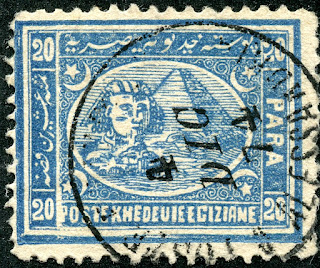Into the Deep Blue
I recently acquired "Page 8 - Egypt" of the Fournier album, where Fournier's forgery wares were exhibited.
As I have just completed a series of blog posts on these very issues, this should be a good time to show some forgeries. The forgeries shown here are no means exhaustive, but Fournier forgeries (whether he did the forgeries himself, or fenced them for other forgers) are relatively common, and I have one 1867 issue Torres forgery to show as well.
The format will be relatively simple for the genuine/forgery stamps I have for these issues. I will illustrate a genuine, and then a forgery. We will then compare/contrast to get a better idea of the differences. We will begin with the 1872 issue.
There are actually two designs (Scott A9 & A10) for the 5pa brown. I'm showing the 1872 (A9) version, as the 1875 design (A10) is the one with the upside-down "5's", as the lateral side panel dies were clamped in inverted compared to the center "Sphinx and Pyramid" die. More about this can be found at What are the differences between the 1872 and 1874-75 stamps for Egypt? post. The Fournier forgery (below) follows the 1872 A9 design.
O.K., what are the differences between the 5pa genuine and Fournier forgery?
The color of the 5pa forgery is a sharp "red-brown-red", while the colors of the 1872-75 genuine printings are dull chestnut to dull red brown (shades) to deep red brown. Compare. There is a sharp difference.
The eyes are more bead shaped in the forgery, rather than horizontally elongated as in the genuine.
1) The forgery cancel for this forgery (matrixed small squares or diamonds (grid)) is not found as a cancel on the Egypt genuines.
2) The color of the forgery paper is quite white, while the genuines are cream opaque.
3) The perf for the forgery is 12 1/2 (All of the Fournier forgeries for this issue are 12 1/2), while the genuine has a number of Perf combinations. True, the 1874-75 genuine printings do have a Perf 12 1/2, with rough perforations, and blurred impressions on thinner paper: this genuine Perf will need to be distinguished from the Forgery perf.
4) No "Crescent and Star" watermark (Wmk 119) found on the forgeries.
The 1872-75 10pa genuine printings come in dull violet to reddish violet; pale slate to deep slate.
The 10pa Fournier forgery is in a deep purple color: not seen with the genuines.
In addition (along with Differences 1-4 listed above)...
5) In the forgery, the Sphinx looks worried, and the eyes gaze off to the left. The genuine can have the eyes looking to the left also, but just looking, and not so worried. ;-)
6) 25 discrete horizontal lines on the left of the sphinx in the oval. (above the neck of the Sphinx), is noted with the genuine, while the forgery has 24 lines.
7) For the right ear of the sphinx, the inside stroke line is vertical for the forgery; slanted to the right in the genuine.
The color of the genuine 20pa range from Prussian Blue to Slate-blue to grey-blue and (Rare-azure (light sky blue)).
The color of the forgery is deep blue, unlike any genuine color.
The 2's in "20" in the four corners are thinner and elongated compared to the genuine.
In addition, (besides 1-7 above)...
8) The four corner 5-point stars have a different shape in the forgery compared to the genuine.
The forgery is red, plain and simple.
The genuine 1's in the corners are fatter in the genuines compared to the forgery.
In addition, (besides 1-8 above)...
9) The curly-cue arabesque background in the four corners around the crescents and stars (outside the oval) are different between the genuine and the forgery.
10) Also, the right cheek of the forgery sphinx has a longer diagonal stroke line compared to the genuine.
The colors of the genuine 5pi range from green to bright green to yellow green.
The 5pi Fournier forgery has a iridescent yellowish green color. Although different than the genuines, I think one will have to also look for other signs that it is a Fournier forgery.
In addition, (besides 1-10 above)..
11) The alphabet printing in the lower horizontal panel is thinner in the forgery compared to the genuine.
12) The Arabic script in the left vertical panel is thinner in the forgery.
Summary: The 1872-75 Egypt Fournier forgery (presumedly lithographic) is rather good, and could fool an observer, unless one has a genuine to compare. In fact, in some detail, the Fournier is more prominent ( the curly-cue arabesque background). It appears that the forgery is from one Die, except, of course, for the different numerals. Nevertheless, there are occasional differences in the forgery (plate wear?).
I should mention that, besides the differences pointed out here, I'm sure the reader can find more.
But, to remind, the major differences include a different color, a constant 12 1/2 perf, and no watermark.
Getting back to the 1867 issue, here is a 2pi blue genuine.
The sphinx face on the Torres forgery looks much different, especially the eyes and mouth.
Shown here is a 5pi brown genuine for the 1867 issue.
The color of the 5pi Fournier forgery is red brown, different than the genuines. It is also imperforate, and might be a proof. The 5's on either side are smaller and lean backwards. The lower horizontal panel Arabic script is not the same between the 5pi forgery and genuine.
Interestingly, the 1867 1pi lower panel inscription resembles the 5pi Fournier forgery from left through center, but not the character center-right.
To cap it off, the sphynx head has been differences between the genuine and the Fournier forgery. See if you can spot them.
Out of the Blue
I hope you enjoyed this little excursion into Egypt's 1867 & 1872-75 forgeries.
Comments appreciated!


















No comments:
Post a Comment